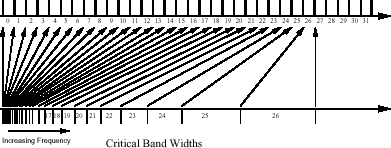Difference between revisions of "Bark"
From Hydrogenaudio Knowledgebase
(I have seen two ways to write the equation. This one should be fine. The Bark ranges might be well suited organized into a table.) |
m (→References) |
||
| (2 intermediate revisions by one user not shown) | |||
| Line 12: | Line 12: | ||
Example: Widths of the [[critical band|critical bands]] gets wider towards the higher [[frequency|frequencies]]. [[MP3]] 32 equal width [[subband|subbands]] (shown on top), based upon PQF filterbank cover the 22.05kHz [[bandwidth]]. The width of 1 [[MP3]] [[subband]] is about <math> 689Hz (32*689=22.05kHz)</math>. [[Ogg Vorbis]] uses Bark Scale mapping in it's filterbank decomposition. Both Bark and ERB bilinear transforms are equivalent in representing the critical bands of human auditory system. | Example: Widths of the [[critical band|critical bands]] gets wider towards the higher [[frequency|frequencies]]. [[MP3]] 32 equal width [[subband|subbands]] (shown on top), based upon PQF filterbank cover the 22.05kHz [[bandwidth]]. The width of 1 [[MP3]] [[subband]] is about <math> 689Hz (32*689=22.05kHz)</math>. [[Ogg Vorbis]] uses Bark Scale mapping in it's filterbank decomposition. Both Bark and ERB bilinear transforms are equivalent in representing the critical bands of human auditory system. | ||
| − | == | + | ==References== |
| − | * | + | * Smith, O. Julius. Abel, Johnathen. "Bark and ERB Bilinear Transforms". Dec 1999 |
| − | + | :<http://citeseer.ist.psu.edu/smith99bark.html> (17 Feb 2007) | |
| + | * Smith, O. Julius. "The Bark Frequency Scale (condensed)". 3 Jan. 2006. | ||
| + | :<http://ccrma.stanford.edu/~jos/bbt/Bark_Frequency_Scale.html> (17 Feb 2007) | ||
| + | |||
| + | [[Category:Psychoacoustics]] | ||
Latest revision as of 19:43, 17 February 2007
The Bark is the standard unit corresponding to one of the 24 critical bands representing the width of human hearing system. Human hearing critical bands are narrow at low frequencies, but become wider at higher frequencies.
(in Hz) 
converting a f to it's bark equivalent:

Example: Widths of the critical bands gets wider towards the higher frequencies. MP3 32 equal width subbands (shown on top), based upon PQF filterbank cover the 22.05kHz bandwidth. The width of 1 MP3 subband is about  . Ogg Vorbis uses Bark Scale mapping in it's filterbank decomposition. Both Bark and ERB bilinear transforms are equivalent in representing the critical bands of human auditory system.
. Ogg Vorbis uses Bark Scale mapping in it's filterbank decomposition. Both Bark and ERB bilinear transforms are equivalent in representing the critical bands of human auditory system.
References
- Smith, O. Julius. Abel, Johnathen. "Bark and ERB Bilinear Transforms". Dec 1999
- <http://citeseer.ist.psu.edu/smith99bark.html> (17 Feb 2007)
- Smith, O. Julius. "The Bark Frequency Scale (condensed)". 3 Jan. 2006.
- <http://ccrma.stanford.edu/~jos/bbt/Bark_Frequency_Scale.html> (17 Feb 2007)
